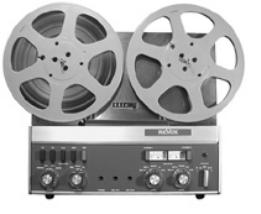Revox A-77 Mk3 User Manual

1972 Revox A77 mk III & IV
Revox A77 mk III & mk IV
Test Report (HI-FI Stereo Buyers' Guide, Fall 1972)
How do you improve upon an already superb tape deck? If you are Revox you simply avoid gimmicks that would only complicate what is probably the easiest-to-operate mechanism - whether professional or amateur - and concentrate on squashing the tape noise through use of a Dolby B noisereduction system. The fact is, the only apparent difference between the old A77 and the Dolby A77 is the Dolby system. Well, it's the Dolby, but with a big difference. You don't get a calibration tape with the Revox because the machine is supplied so precisely adjusted you don't have to match tapes, make any corrections, or do anything other than record as you normally would.
To avoid unnecessary duplication you can look up the specs on the Revox Dolbyized A77 in the test reports; we'll get right down to basic differences. First off, the only apparent difference between a standard A77 and the Dolby A77 is two small switches at the bottom edge of the front panel. One switch is the Dolby selector, the other is the filter for the FM-stereo pilot signal, as Dolby circuits easily get "loused up" if pilotsignal leakage from a receiver rides along with the audio signal into the recorder. The only other apparent difference is the tape-monitor switch. The original A77 switch had three positions: one for NAB equalized-playback, one for CCIR equalized playback and one for source monitoring. The new tape-monitor switch still has three positions but the CCIR play equalization is now replaced by a Dolby calibration oscillator. By placing the switch in the CAL position, a tone signal is automatically applied to the recording amplifiers.
That's the whole change in external appearance. The other obvious change lies behind the dropdown strip that conceals the tape-drive path and the REEL MOTORS OFF switch on the standard A77. The Dolby A77 no longer has the reel-motor control switch. (Brake tension has been reduced to simplify threading.) in place of the switch are two controls for Dolby recording channels. In typical use you would simply set the tapemonitor switch to CAL and adjust the Dolby-level controls for a zero-VU reading on the meters. That's the whole Dolby alignment procedure.
Where did they put it? Since the Dolbyized Revox A77 has both record and play Dolby equalizers, so you can simultaneously playback the deprocessed recording, a lot of space was required under the deck. The standard A77 already had space for pre-wired sockets that accommodated plug-in power amplifiers. The sockets were also pre-wired to two speaker-output jacks on the connection strip along the top edge of the rear apron. You will find that on the Dolby model the holes for the jacks are now plugged, as the Dolby printedcircuit boards utilize the space reserved for t-he power amplifier plug-ins. This Arrangement retains all the conveniences of the standard A77 such as plug-in record and play amplifiers and complete user access to the bias and equalizer adjustments.
Performance is like WOW! The non-Dolby performance is just as it was for the standard model. superb. (Again, to save space we'll let you refer to the test report in this issue.) The only thing the Dolby does is to reduce the noise level to a rock-bottom -62 dB narrow band, which is superior to the signal-to-noise ratio of many non-Dolby full-track professional recorders. in order to obtain this excellent signal-to-noise ratio you must keep in mind that the A77 is a professional machine and has professional VU-meter calibration: zero VU is 10 dB below tape saturation (3% THD) and you need not reduce the recording level to avoid peak-signal
file:///P|/9105%20werkdirectorie/Manufacturers,%20Manuals/Tapedeck/tests/9160CMREV-REV-A77mk3.htm (1 of 2)1-11-2003 11:03:09
